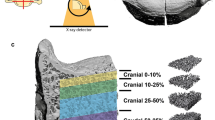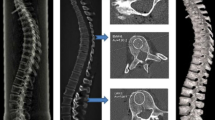Abstract
Purpose
Subchondral bone (SCB) of the vertebral endplates (VEP) is the principal site of changes in vertebral trabecular microarchitecture secondary to intervertebral disc degeneration. However, the microstructure of this region has not yet been clearly characterized.
Methods
One thoracic and one lumbar vertebral unit (vertebra-disc-vertebra) was removed in nine pigs aged 4 months. Three samples (one central and two laterals) were taken from each VEP. Micro-CT examination and histomorphometric measurements of the subchondral trabecular bone of the VEP were carried out. Correlations between micro-CT and histological parameters were sought.
Results
Trabecular network was significantly denser [increased bone volume fraction (BV/TV) and trabecular number (Tb.N), decreased intertrabecular separation (Tb.Sp)] in the cranial endplates of the vertebral units. It was also significantly denser and less well organized [increased degree of anisotropy (DA)] in the centre of the VEP. The thickness of the cartilage endplate (CEP), SCB and growth cartilage were significantly lower in the centre of the VEP. There was a significant negative correlation between BV/TV, Tb.N and DA with the thicknesses of the CEP and SCB whereas Tb.Sp was positively correlated with these two parameters.
Conclusion
We observed densification of the trabecular network in the centre of the VEP overlying the nucleus pulposus, partly related to thinner hyaline cartilage. Densification is associated with more anisotropic architecture that could cause lower mechanical strength in this area. This study provides new information on the microarchitecture of the SCB of the VEP which will make it possible to validate future models.




Similar content being viewed by others
References
Accadbled F, Laffosse JM, Ambard D et al (2008) Influence of location, fluid flow direction and tissue maturity on the macroscopic permeability of vertebral end plates. Spine 33:612–619
Aerssens J, Boonen S, Lowet G, Dequeker J (1998) Interspecies differences in bone composition, density, and quality: potential implications for in vivo bone research. Endocrinology 139:663–670
Allan DG, Russell GG, Moreau MJ et al (1990) Vertebral end-plate failure in porcine and bovine models of spinal fracture instrumentation. J Orthop Res 8:154–156
Amstutz HC, Sissons HA (1969) The structure of the vertebral spongiosa. J Bone Joint Surg Br 51:540–550
Aoki J, Yamamoto I, Kitamura N et al (1987) End plate of the discovertebral joint: degenerative change in the elderly adult. Radiology 164:411–414
Costi JJ, Hearn TC, Fazzalari NL (2002) The effect of hydration on the stiffness of intervertebral discs in an ovine model. Clin Biomech (Bristol, Avon) 17:446–455
Donisch EW, Trapp W (1971) The cartilage endplates of the human vertebral column (some considerations of postnatal development). Anat Rec 169:705–716
Flynn MJ, Cody DD (1993) The assessment of vertebral bone macroarchitecture with X-ray computed tomography. Calcif Tissue Int 53:S170–S175
Gong H, Zhang M, Qin L et al (2006) Regional variations in microstructural properties of vertebral trabeculae with structural groups. Spine 31:24–32
Gong H, Zhang M, Yeung HY, Qin L (2005) Regional variations in microstructural properties of vertebral trabeculae with aging. J Bone Miner Metab 23:174–180
Grant JP, Oxland TR, Dvorak MF (2001) Mapping the structural properties of the lumbosacral vertebral endplates. Spine 26:889–896
Hadjipavlou AG, Tzermiadianos MN, Bogduk N, Zindrick M (2008) The pathophysiology of disc degeneration: a critical review. J Bone Joint Surg Br 90:1261–1270
Issever AS, Walsh A, Lu Y et al (2003) Micro-computed tomography evaluation of trabecular bone structure on loaded mice tail vertebrae. Spine 28:123–128
Keller TS, Hansson TH, Abram AC et al (1989) Regional variations in the compressive properties of lumbar vertebral trabeculae. Effects of disc degeneration. Spine 14:1012–1019
Moore RJ (2000) The vertebral end-plate: what do we know? Eur Spine J 9:92–96
Moore RJ, Vernon-Roberts B, Osti OL, Fraser R (1996) Remodeling of vertebral bone after outer anular injury in sheep. Spine 21:936–940
Müller R (2002) The Zürich experience: one decade of three-dimensional high-resolution computed tomography. Top Magn Reson Imaging 13:307–322
Oxland TR, Panjabi MM, Southern EP, Duranceau J (1991) An anatomic basis for spinal instability: a porcine trauma model. J Orthop Res 9:452–462
Roberts S, McCall IW, Menage J et al (1997) Does the thickness of the vertebral subchondral bone reflect the composition of the intervertebral disc? Eur Spine J 6:385–389
Roberts S, Menage J, Urban JP (1989) Biochemical and structural properties of the cartilage end-plate and its relation to the intervertebral disc. Spine 14:166–174
Simpson EK, Parkinson IH, Manthey B, Fazzalari N (2001) Intervertebral disc disorganization is related to trabecular bone architecture in the lumbar spine. J Bone Miner Res 16:681–687
Smit TH (2002) The use of a quadruped as an in vivo model for the study of the spine—biomechanical considerations. Eur Spine J 11:137–144
Sran MM, Boyd SK, Cooper DM et al (2007) Regional trabecular morphology assessed by micro-CT is correlated with failure of aged thoracic vertebrae under a posteroanterior load and may determine the site of fracture. Bone 40:751–757
Teo JC, Si-Hoe KM, Keh JE, Teoh SH (2006) Relationship between CT intensity, micro-architecture and mechanical properties of porcine vertebral cancellous bone. Clin Biomech (Bristol, Avon) 21:235–244
Thompson RE, Pearcy MJ, Downing KJ et al (2000) Disc lesions and the mechanics of the intervertebral disc complex. Spine 25:3026–3035
Urban MR, Fairbank JC, Etherington PJ et al (2001) Electrochemical measurement of transport into scoliotic intervertebral discs in vivo using nitrous oxide as a tracer. Spine 26:984–990
Acknowledgments
The authors thank Pr Jean Puget for his technical support. All experiments were carried out at the Ecole Nationale Vétérinaire, Lyon, France, in accordance with current regulations on the care and use of experimental animals.
Conflict of interest statement
The authors declare that they have no conflict of interest.
Author information
Authors and Affiliations
Corresponding author
Rights and permissions
About this article
Cite this article
Laffosse, JM., Kinkpe, C., Gomez-Brouchet, A. et al. Micro-computed tomography study of the subchondral bone of the vertebral endplates in a porcine model: correlations with histomorphometric parameters. Surg Radiol Anat 32, 335–341 (2010). https://doi.org/10.1007/s00276-009-0569-9
Received:
Accepted:
Published:
Issue Date:
DOI: https://doi.org/10.1007/s00276-009-0569-9




